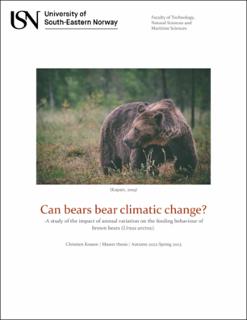| dc.description.abstract | Climate change is a topic of global importance, affecting species and ecosystems worldwide. Climatic variations and changes, like anthropogenic changes, have vast effects on plant-life, wildlife, and fungi alike. Nordic areas are especially sensitive, with temperatures in Scandinavia rising faster than in many other countries on earth (Walther et al., 2002). These changes can impact the quantity and quality of food items, potentially influencing life-history traits of animals living in the Scandinavian boreal forests. This could be particularly true for hibernating species, such as the brown bear (Ursus arctos). Before hibernation in late autumn, bears must increase adipose tissues for successful reproduction and survival during hibernation. The feeding behaviour of brown bears is likely to be impacted by climatic changes, as they rely heavily on berries, vertebrates, insects, and vegetative materials for survival.
In this study, a total of 352 scat samples were collected in a non-invasive manner, ranging from 2015-2019 from brown bears in Sweden and analysed from their dietary components. These samples came from 65 bears, of which 57 were adults and 8 were subadults. There were 49 females and 16 males. This study has shown a strong annual correlation between temperatures and the feeding behaviour of brown bears in Sweden. There was a significant annual variation in the diet of the bears, as well as the proportion of the components. Of the three berry species analysed, bilberry (Vaccinium myrtillus), was found declining in favour of lingonberry (Vaccinium vitis-idaea), and crowberry (Empetrum hermaphroditum).
Males eat significantly less bilberries than females and there are significant differences in the amount of bilberries that the bears eat per year. The quantity of bilberries decreased over time. The more bilberries consumed by the bears during a year, the less lingonberries and crowberries are consumed and vice versa.
Between 2015 and 2019, there are clear annual dietary variations. In 2015, bilberry made up 66.83%, lingonberry made up 1.96% and crowberry made up 0.89% of the diet of the bears. In 2016, the berry contents of bilberry, lingonberry, and crowberry were 59.01%, 1.21%, and 2.03% respectively. In 2017, bilberry was 24.49%, lingonberry was 7.79%, and crowberry was 13.31%. In 2018, bilberry rose to 36.64%, lingonberry rose to 10.57%, and crowberry rose to 25.05%. Lastly, in 2019, bilberry dropped to 5.56%, lingonberry rose to 27.78%, and crowberry was not present at all.
This data was compared to climatic variations in the area and the results were that there is a clear indication of an increased annual temperature with a steady incline from 2015 to 2019. The food items consumed by the bears seem resilient to colder temperatures, as there was little to no change in the feeding behaviour during 2015-2016. On the contrary, as temperatures rise from 2016 and onwards, changes happen in the feeding behaviours. Figure 6 shows a drastic temperature increase in 2019. This is mirrored by the results shown in figure 7. In 2019, 0.01% insects were found in the bear scat. Oats decreased from 12.75% in 2018 to 5.54% in 2019.
In essence, all abovementioned figures are indicative of a relationship between climatic variation and the feeding behaviour of the brown bears. When climate changes, so does the feeding behaviour of brown bears.
Despite being able to be flexible in their dietary requirements and resilience towards changes in their surroundings and availability of resources, a changing climate and anthropogenic impact may affect the feeding behaviour of brown bears. These factors must be monitored in ordered to properly implement conservational and management efforts. As a keystone and umbrella species, any negative affect on the bear populations may drastically affect the entire ecosystem. Therefore, long term dietary studies can help to evaluate to what extent climatic change affects the feeding behaviour of the brown bear. | |
